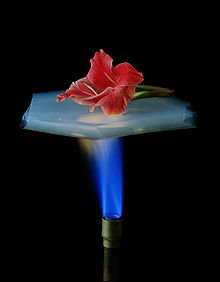Aerogel

Aerogel is a gel in which the liquid part has been replaced with a gas (usually air). It was invented in 1931 by Samuel Stephens Kistler. The most common type of aerogel is silica aerogel, which is made from the same molecule as glass. It is a solid material that is almost as light as air. It is the world's lightest material.[1] Its melting point is 1200 degrees Celsius, which is comparable to crocidolite asbestos. Aerogel is the best thermal insulator available and can be used in construction in place of fiberglass insulation. It allows better insulation with less material, although it is much more expensive than fiberglass. It is also brittle, making it more difficult to install than fiberglass. Most aerogel is not water-resistant, and even small amounts of water can destroy it. It is also safer than fiberglass or asbestos because it is not known to cause cancer if inhaled into the lungs.[2] Some aerogel insulation, however, contains fiberglass to increase its flexibility.[3]
References
[change | change source]- ↑ Quick, Darren (March 24, 2013). Graphene aerogel takes world’s lightest material crown Archived 2013-03-25 at the Wayback Machine. gizmag.com
- ↑ Cryogel 5201, 10201 Safety Data Sheet Archived 2010-12-23 at the Wayback Machine. Aspen Aerogels. 11/13/07
- ↑ "Aerogel-definition, characteristics and application". Archived from the original on 2021-08-20.
Other websites
[change | change source]![]() Media related to Aerogel at Wikimedia Commons
Media related to Aerogel at Wikimedia Commons
